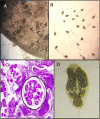Gonadal cycle, reproductive indices and detection of parasitism in the clam Ameghinomya antiqua in natural beds of importance for fisheries
- PMID: 35395031
- PMCID: PMC8992985
- DOI: 10.1371/journal.pone.0266538
Gonadal cycle, reproductive indices and detection of parasitism in the clam Ameghinomya antiqua in natural beds of importance for fisheries
Abstract
The clam Ameghynomia antiqua is a highly important resource for fisheries due to its high catches volume. It is the bivalve mollusc with the highest fisheries landings from natural beds on the Pacific coast of southern South America; however, studies of the reproductive conditions of this species are scarce and date back many years. The object of the present work was to evaluate the reproductive characteristics of the species, analysing its gametogenic and gonadal cycle, and reproductive indices, in fishery locations that present the natural beds with the highest fisheries catches, as well as parasite loads in the species. The gonads of the individuals were sampled monthly over a year and classified into one of three states called: "in development", "ripe" and "spawned". Synchrony between the sexes was observed in the indicators of the Gonadosomatic Index and Condition Index in each of the locations, although no synchrony was observed between locations. In the gametogenic cycle, the "ripe" state was observed in females in spring-summer, followed by rapid recovery to new development of the gonads; in males the "ripe" state was observed throughout the year. It was observed that males entered the "spawned" state one month ahead of females. The presence of digenean parasites in the state of metacercariae was detected in the gonads and mantle. No significant differences were found in the prevalence or intensity of infection when analysed by sex and month. The metacercariae were identified, by sequencing of three DNA regions, as belonging to the clade shared by species of the genus Parvatrema and close to the Gymnophalloides; both these genera belong to the family Gymnophallidae of the superclass Digenea. Infection was observed to reduce the gonadal tissue, in some cases causing castration. This is the first record of the presence of these parasites of A. antiqua, with genetic identification at genus level. These results are relevant for act proper management of this resource, which is important for fishing.
Conflict of interest statement
The authors have declared that no competing interests exist.
Figures





References
-
- Seed R. Ecology: Marine mussels their ecology and physiology. In: Bayne BL, editor; Cambridge University Press; 1976. Pp. 13–66.
-
- Arsenault DJ, Himmelman JH. Spawning of the Iceland scallop (Chlamys islandica Muller, 1976) in the northern Gulf of St. Lawrence and its relationship to temperature and phytoplankton abundance. Veliger. 1998; 41: 180–185.
-
- Galtsoff PS. The American Oyster Crassostrea virginica Gmelin. Fish Bull. 1964; 64: 1–480.
-
- Sastry AN. Pelecypoda (excl. Ostreidae). In: Giese AC, Pearse JS, editors. Reproduction of marine invertebrates Vol. 5. Academic Press, New York; 1979. Pp. 113–292
-
- Mackie G. Bivalves. In: Tompa A, Verdonk N, Van den Biggelaar J, editors. Mollusca. Academic Press, New York, United State, 1984. Pp. 351–418.
Publication types
MeSH terms
LinkOut - more resources
Full Text Sources

